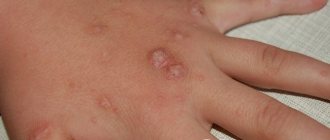Growths can appear in anyone, regardless of age and gender. In most cases, they pose no threat to humans. But if growths on the skin appear in inconvenient places, are constantly injured, change their shape and size, you should take a closer look at them and, if necessary, visit a doctor.
What happens if you tear off a papilloma on a leg?
When a pedunculated papilloma is detached from the base, the benign neoplasm begins to become inflamed.
This creates a wound surface.
All this is accompanied by itching and increased body temperature.
There is suppuration and swelling due to the inflammatory reaction.
Remains of papilloma must be removed in a hospital setting.
Such injuries threaten the degeneration of a benign papilloma into a malignant neoplasm.
Sometimes, with good immunity, papillomas come off and new ones do not grow.
There is no negative impact.
The recovery is complete.
Periungual, plantar, filiform warts
Types and characteristics of warts:
- Periungual warts are benign formations that do not pose any particular danger to the body. Most often, periungual warts are formed due to type 2 virus. The main places of damage: cuticle, under the nails. The virus that causes periungual warts can be contracted from a sick person. In addition, the virus can enter the human body through minor injuries and cuts to the skin.
- Plantar warts appear as round-shaped growths that are quite dense. Plantar warts typically form on the feet and toes. The main reason for the formation of plantar warts is the presence of the papilloma virus in the body. Here you can read detailed information about this type of growth and see a photo of a plantar wart.
- Filiform warts are thin growths that form on the skin of the face and in the folds of the skin. The size of the formations can reach 6 mm in length. Filiform warts are caused by the papilloma virus and can spread to adjacent areas of the skin.
You might be interested! Skin fibroma: photos, causes, treatment and consequences
Symptoms
Symptoms of periungual warts:
- Growths located in the nail area
- Flat and oval shape of growths
- Rough surface
Symptoms of plantar warts:
- Dense round growth on the sole
- Pain when walking
- Itching in the area of formation
Symptoms of a filamentous wart:
- Elongated lump-shaped formation
- The length of the growth can reach 6 mm
- The color of the formation can vary, ranging from flesh-colored to brown
Photos of warts
Periungual wart:
Plantar wart:
Filiform wart:
How to distinguish a papilloma from a mole
The papilloma is colorless and pedunculated.
A nevus or wart does not have a stalk and is brown in color.
It is advisable to remove papillomas, since they are most often located in areas of increased trauma and are not very aesthetic.
As a rule, moles do not pose any danger.
They do not have a special function and in their structure contain various pigments in large quantities.
Condylomas are growths on the skin in the groin and anus.
The reason is the same - the papilloma virus. Characteristic smooth or rough growths, ranging in size from one millimeter to 3 cm. They can be single or merged. Localized in the genital and anus areas. In men - near the head and crown of the penis, frenulum. In women, they are located on the labia, clitoris, less often on the cervix, inside the vagina. Growths on the skin in the genital areas during sexual intercourse cause discomfort and complicate the birth process. Multiple proliferation of condylomas is a sign of a weakened immune system. Infection with growths occurs during sexual intercourse with a carrier of the virus, very rarely through household means.
Pedicled papilloma: diagnosis, histology
Pedicled papillomas, like other papillomas, must be subjected to histological examination.
This will complement the cytological examination.
The histological examination method consists of analyzing a biopsy specimen - a part of the papilloma obtained during its removal.
A microscope is used for this.
We evaluate the nature of the benign tumor and determine the degree of oncogenicity of the papilloma.
Within three days after the study, we have the result.
The diagnosis of papillomatosis when infected with HPV occurs on the basis of laboratory diagnostics:
- cytological analysis (to determine changes in the cellular material of the test sample);
- carrying out a polymerase chain reaction (to find viral DNA in the material under study);
- obtaining a biopsy specimen for histological examination;
- carrying out the histological examination itself;
- conducting a daijin test.
The Daijin test is carried out to determine the type of HPV, its quantity and degree of oncogenicity.
Without laboratory research methods, based only on the clinical picture, even an experienced doctor has difficulty in making a correct and accurate diagnosis.
Symptoms
It will be possible to understand the origin of a volumetric process only after analyzing all the information about its nature. This is impossible without considering the clinical picture of the pathology - the sum of subjective and objective symptoms identified during a medical examination.
Benign tumors
Those people who have a lump on their nose need to think about the likelihood of tumors. If the neoplasm is benign, it grows slowly, is limited in nature and does not destroy surrounding tissue. Pathological growth can occur in cells of any tissue group, which is why there are many different conditions.
Formations that protrude above the surface of the skin of the nose, as a rule, are formed from it. Pigmented nevi and papillomas are superficial, while fibromas lie deeper. The former are easy to detect by their dark coloration caused by melanocytes. Papilloma looks like papillary growths or cauliflower, having a lumpy surface and a soft consistency. A fibroma is a denser ball in the thickness of the skin, but it can also grow on a stalk. This is exactly what a bump under your nose may look like.
Fibroma can grow from cartilage and the nasal septum, and osteoma can grow from bone formations. By blocking the lumen, they create a feeling of congestion, interfere with breathing and contribute to the appearance of inflammatory reactions. Difficulty in the outflow of secretions and irritation of the mucous membrane are favorable conditions for rhinitis (runny nose). Associated with the epithelial lining are cystic formations that form when the glands are blocked. Unlike chondromas, fibromas and osteomas, they are soft and, as a rule, do not reach large sizes.
Angiomas formed from vascular loops require special consideration. They can be capillary, cavernous and mixed, have a red-burgundy or bluish color, and are soft to the touch. When pressed, the vascular tissue collapses and the skin becomes paler. Basically, angiomas are of congenital origin, and the facial area is their most common location.
Tumor formations that are benign in nature can come from any tissue of the nose.
Inflammatory pathology
Inflammatory acne on the face is a fairly common occurrence. But a boil is a more serious disease that affects the hair follicle with the sebaceous gland. Microbial inflammation is promoted by skin pollution, hypothermia and decreased immunity. There are especially many hair follicles around the nose in men, but the mucous membrane of the nostrils also contains them.
First, people notice how redness and painful swelling appear on the skin, and especially severe discomfort is caused by an inflammatory lump in the nose. Next, the boil matures, which is accompanied by a deterioration in the general condition and fever. Gradually, the abscess increases in size, swelling increases, pain intensifies and nasal function is impaired. The formation of a necrotic core is indicated by the appearance of a pustule at the top of a cone-shaped lump. A boil breakthrough is characterized by the discharge of pus and an improvement in well-being.
Ulcers in the area of the upper lip and nose are very dangerous. These zones have a common blood flow with the cranial cavity, so the infection, if detected late and treated incorrectly, can penetrate the vascular network. This leads to cavernous sinus thrombosis, meningitis and abscesses, and may result in a septic condition.
Malignant processes
A malignant tumor is especially dangerous. In this case, the clinical picture becomes brighter and the process progresses faster. Among the symptoms that may indicate oncology are the following:
- Ulcer formation.
- Discharge of pus.
- Bleeding.
Melanoma looks like an asymmetrical mole that has changed its color (darkened or lightened), has an uneven color and unclear boundaries. Any malignant formation is characterized by rapid growth, adhesion to surrounding tissues and signs of destruction. Large tumors can destroy the outer nose and lead to facial disfigurement. And when metastases appear, other disorders occur (dizziness, headaches, intoxication, emaciation).
The possibility of a malignant tumor can be excluded only with a detailed examination of the patient.
Complications of papillomas
The most important complication is the degeneration of benign neoplasms into malignant tumors.
It is necessary to determine as quickly as possible the type of HPV that caused the formation of papillomas.
If it is a highly oncogenic type 16 or 18, constantly monitor the development and changes in the condition of papillomas.
These pedunculated papillomas also threaten traumatization and relapse.
You should always remember this and avoid injury, and after removing papillomas, prevent their occurrence.
Causes
Causes of acne and bumps on the face
After the final paragraph in the previous section, the question rightly arises: is it possible to avoid the appearance of such troubles on the face as a pimple or even a scattering of them, blackheads, lumps, wen and other formations that spoil external beauty and affect health?
Many will answer that maintaining personal hygiene and timely facial skin care will help avoid this, and in the vast majority of cases they will be right. However, in order to know exactly how to deal with this scourge, which for some people, regardless of age, gender and type of activity, is a real problem, you need to know the reasons for their appearance.
And there are several of them:
The appearance of pimples and bumps on the face
- problems with hormonal levels.
- improper diet and consumption of harmful foods.
- alcohol, smoking and other bad habits.
- allergic reactions.
- disease of the nervous and endocrine systems.
- injuries.
- genealogical factor.
- overheating or, conversely, hypothermia.
- infection.
- abuse of synthetic cosmetics.
- and of course, inappropriate facial skin care.
At first glance, there are quite a few reasons and observing them all is too problematic in our accelerated world, filled with stress and harmful emissions. However, if you analyze the entire list, it becomes clear that most of them are associated with an incorrect lifestyle. So there is nothing complicated about this, you just need to take care of your general health, not only when the problem is already obvious, but also at a time when everything is fine and it seems that there is nothing to worry about.
Degeneration of papillomas into malignant pathology
We must always remember that HPV poses a risk of cancer.
Especially highly oncogenic types, for example, 16 and 18.
Typically, malignant degeneration of papillomas cells takes ten to twenty years from the moment of infection.
The process is accelerated by smoking, drinking alcohol, obesity and hormonal disorders that reduce immunity.
It is the decrease in immunity, which occurs for various reasons, that contributes to the activation of HPV and the transition of the benign state of papillomas to a malignant pathology.
The destruction of papillomas is enhanced by cytomegalovirus, genital herpes, chlamydia, syphilis, gonorrhea, and trichomoniasis.
And of course, you need to avoid frequent trauma to papillomas, which contributes to their malignancy.
A direct indication for removal of papillomas is the presence of large papillomas.
They are often hurt and hurt.
Methods for removing papillomas
There are quite a lot of methods for removing papillomas.
Let's consider everything.
Firstly, it is the destruction of papillomas using a special liquid containing alkali.
They are purchased in pharmacies with prescriptions from the attending physician.
The disadvantage is considered:
- the need for precise local application of liquid to papillomas,
- risk of chemical burns to adjacent tissues,
- painful procedure,
- the possibility of scars appearing at the site of papillomas removal.
Usually, the method is used to remove single vulgar papillomas (warts) of the hands.
It is not suitable for filamentous papillomas.
Refrigerants are used for cryodestruction.
Basically, liquid nitrogen is used.
Although other refrigerants are possible.
The application of the coolant is painless; acute pain occurs later when “defrosting” occurs.
After a certain time, the surrounding tissues turn red and swell.
There is an active formation of a subcutaneous bladder filled with fluid.
After a week (maximum one and a half months), everything heals and is restored.
It takes three weeks for the tissue under the crust to die, while the infected tissue is reliably destroyed.
There are no scars, and any traces disappear within six months.
The intimate area and face are not treated with this method.
Firstly, the genital area is very sensitive.
And secondly, it is not suitable for the face due to post-operative swelling and redness of the surrounding tissues.
Using a special device, papillomas are removed using radio wave coagulation.
Most often they use Surgitron.
The method does not cause pain.
Several radioknives in the kit allow you to choose the most convenient one for papilloma of a given location.
The radioknife provides directed high-frequency radiation, which cuts off the papilloma, “evaporating” its tissue.
There is no rehabilitation period.
The operation is quick, painless and leaves no traces of the intervention.
But if there are acute inflammatory processes or worsened chronic ones, then radio wave coagulation is not used.
Diabetes mellitus, pregnancy, lactation and any cancer pathology in the body are also contraindications for using the method.
But if there are no contraindications, the method can be successfully used anywhere.
Patients say that the only drawback of the method is the discomfort at the time of administration of the anesthetic.
Laser beams are also used to remove papillomas without contact.
Healthy tissues are not damaged.
Infected papilloma tissues seem to “evaporate” under the action of a laser beam.
A session of laser removal of papillomas does not take long, just a few minutes.
Complete rehabilitation takes place in two weeks.
Side effects include prolonged redness of the skin and swelling of adjacent tissues.
Problems with the thyroid gland contribute to the formation of keloid scars.
Contraindications for the use of laser coagulation are the presence of:
- diabetes mellitus;
- acute inflammatory processes;
- epilepsy;
- disorders of endocrine and immune status;
- photoderomatosis;
- thrombocytopenia.
Patients who have undergone laser coagulation report pain and an unpleasant “burnt meat” smell.
Long-term rehabilitation, pain and tendency to relapse with this method.
Small papillomas are removed by electrocoagulation or cauterization.
Rehabilitation takes place within a week.
Reliable and inexpensive method.
Any localization of papillomas is suitable for its use.
To remove large papillomas or malignant neoplasms, a scalpel is used.











